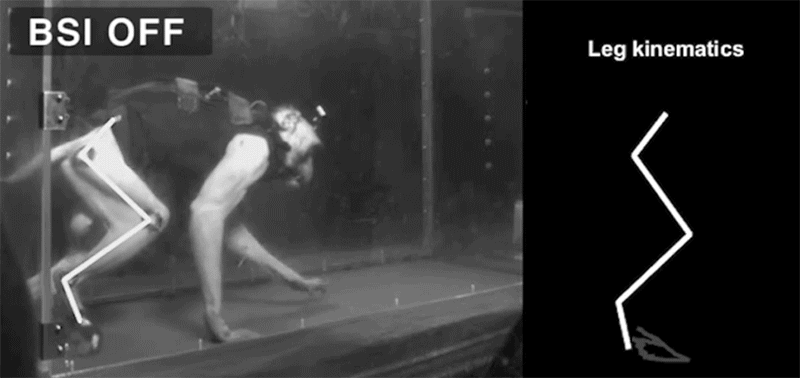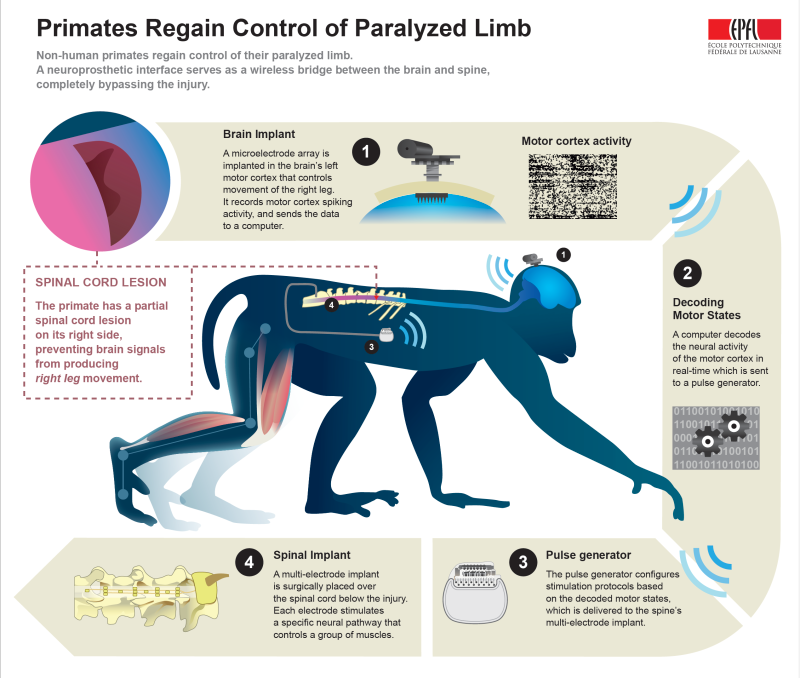
In an unprecedented event, scientists restored locomotion in paralyzed primates using an implanted neural device, granting hope to the 1,275,000 people who have paralysis from spinal cord injuries.
A new study published in the science journal Nature describes a neuroprosthetic interface, or “brain-spine interface,” that acts as a wireless bridge between the brain and spinal cord, bypassing the zone of injury. The device restored mobility in the paralyzed right leg of two rhesus monkeys, fueling a sense of optimism for the future possibility of human adaptation. Grégoire Courtine — who developed the device with his colleagues at the Swiss Federal Institute of Technology in Lausanne and researchers at the University of Bordeaux, Motac Neuroscience, and the Lausanne University Hospital (CHUV) — first restored mobility in paraplegic rats back in 2012. Courtine injected the rats with a chemical combination that “reawakened” damaged spinal cord tissue, enabling the rats to walk, run, and dodge obstacles.
Four years later, the new experiment relies on a neuroprosthetic implant grafted directly to the brain and the area of injury. It aims to bypass the spinal cord lesions that block signals sent from the motor cortex to the neurons responsible for activating the muscle.
Paralyzed monkeys implanted with the device regained the ability to walk within six days. After delivering a controlled burst of voltage at the right location, the neuroprosthetic device successfully interpreted and relayed brain activity to an electrode array placed below the injury on the spinal cord. Full mobility in those inflicted with partial lesions inflicted to the spinal cords was restored within three months — no therapy or external wires necessary; the device is self-contained.
“The primate was able to walk immediately once the brain-spine interface was activated,” said study co-author Erwan Bezard of Bordeaux in a statement. “No physiotherapy or training was necessary.”

How it works
The interface essentially decodes information from the brain using an external computer. The process begins with the electrode in the small region of the cortex that controls the leg sending information from all of the neurons to a computer, which interprets the motor intention of the primates based on the signal — the extension and contraction movement of the leg. The computer then sends the information to an implanted stimulator that activates the correct location at the correct timing.
What’s next?
Looking ahead, scientists hope the device functions with severe injuries, although it’s speculated to require additional intervention from chemical and electrical stimulation. The study’s researchers say that adapting the technology for human treatment requires dealing with key locomotion issues unaddressed by the experiment — balance, steering, and obstacle avoidance. If the interface cannot restore movement directly, it may contribute toward rehabilitating the surviving neural pathways: connections between two neurons are strengthened when both are simultaneously active.
Excitingly, many of the components used in the brain-spine interface have already been approved for humans, suggesting that human trials may not be too far into the future.
Advertisement
Learn more about Electronic Products Magazine





